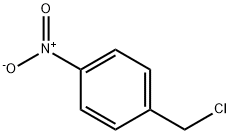1-(클로로메틸)-4-니트로벤젠 C화학적 특성, 용도, 생산
화학적 성질
white to light yellow crystal powde
용도
4-Nitrobenzyl chloride was used to prepare unsymmetrically
N,N′-
bis(substituted) 4,13-diaza-18-crown-6-ether derivatives.
생산 방법
Chlorination of 4-nitrotoluene at 190 ℃ without catalyst gives 4-Nitrobenzyl chloride. The alternative process of nitration of benzylchloride coproduces 2-nitrobenzyl chloride and requires a difficult separation stage.
정의
ChEBI: A C-nitro compound that is nitrobenzene in which the hydrogen at position 4 is replaced by a chloromethyl group.
일반 설명
Solid.
공기와 물의 반응
May react slowly with water.
반응 프로필
Incompatible with sodium hydroxide. [EPA, 1998]. A halogenated aromatic nitro compound. Aromatic nitro compounds range from slight to strong oxidizing agents. If mixed with reducing agents, including hydrides, sulfides and nitrides, they may begin a vigorous reaction that culminates in a detonation. The aromatic nitro compounds may explode in the presence of a base such as sodium hydroxide or potassium hydroxide even in the presence of water or organic solvents. The explosive tendencies of aromatic nitro compounds are increased by the presence of multiple nitro groups.
건강위험
Poisonous if swallowed or dust is inhaled.
화재위험
Incompatible with sodium hydroxide.
잠재적 노출
A chloronitrobenzene compound, used
in organic synthesis.
운송 방법
UN3261 Corrosive solid, acidic, organic, n.o.s.,
Hazard class: 8; Labels: 8—Corrosive material, Technical
Name Required. UN1578 Chloronitrobenzenes, solid or liquid,
Hazard Class: 6.1; Labels: 6.1—Poisonous materials.
Purification Methods
Crystallise the chloride from CCl4, dry diethyl ether, or n-heptane, and dry it under vacuum. IRRITANT.[Beilstein 5 IV 856.]
비 호환성
Can react with sulfuric acid. Keep
away from oxidizers, amines, bases: sodium hydroxide, and
potassium hydroxide; may cause fire and explosions.
Incompatible with strong oxidizing and reducing agents
such as hydrides, certain amines, nitrides, azo/diazo compounds,
alkali metals (potassium), and epoxides. Corrodes
steel, some plastics and human tissue.
1-(클로로메틸)-4-니트로벤젠 준비 용품 및 원자재
원자재
준비 용품








